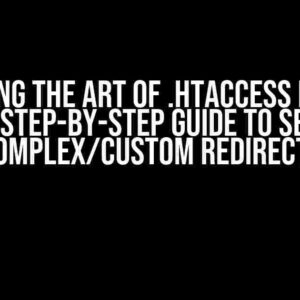Are you tired of dealing with conflicting coordinates in JavaScript? Do you find yourself lost in a sea of event.clientX, Y, event.pageX, Y, window.scrollX, Y values? Fear not, dear developer! Today, we’ll embark on a journey to demystify the relationship among these seemingly mysterious variables, and unlock the secrets to achieving subpixel accuracy in your JavaScript applications.
The Coordinate Conundrum
When working with JavaScript events, it’s essential to understand the coordinate systems involved. You’ve probably encountered the following properties:
- event.clientX and event.clientY
- event.pageX and event.pageY
- window.scrollX and window.scrollY
But what do they really represent? Let’s dive deeper to explore each property and its significance.
event.clientX and event.clientY: The Relative Heroes
The clientX and clientY properties provide the coordinates of the event relative to the viewport, excluding any scroll offset. Think of it as the position of the event within the visible area of the browser window.
event.clientX = The X coordinate of the event relative to the viewport
event.clientY = The Y coordinate of the event relative to the viewportImagine you’re clicking on a button at the top-left corner of the browser window. The event.clientX and event.clientY values would be (0, 0), regardless of the scroll position.
event.pageX and event.pageY: The Absolute Champions
The pageX and pageY properties provide the coordinates of the event relative to the entire document, including any scroll offset. This means that these values take into account the entire document, not just the visible area.
event.pageX = The X coordinate of the event relative to the document
event.pageY = The Y coordinate of the event relative to the documentUsing the same example as before, if you scroll down the page and click on the same button, the event.pageX and event.pageY values would reflect the absolute position of the button within the document, including the scroll offset.
window.scrollX and window.scrollY: The Scroll Superheroes
The window.scrollX and window.scrollY properties provide the current scroll offset of the window.
window.scrollX = The X coordinate of the current scroll position
window.scrollY = The Y coordinate of the current scroll positionWhen you scroll down the page, the window.scrollX and window.scrollY values increase, indicating the amount of pixels scrolled.
The Relationship Revealed
Now that we’ve explored each property individually, let’s examine how they relate to each other.
| Property | Description | Example Value |
|---|---|---|
| event.clientX | Relative to viewport | 100 |
| event.clientY | Relative to viewport | 200 |
| event.pageX | Absolute, including scroll offset | 1500 |
| event.pageY | Absolute, including scroll offset | 3000 |
| window.scrollX | Current scroll offset | 1400 |
| window.scrollY | Current scroll offset | 2800 |
Notice how the event.clientX and event.clientY values are relative to the viewport, while event.pageX and event.pageY values include the scroll offset. The window.scrollX and window.scrollY values represent the current scroll position.
Subpixel Accuracy: The Secret to Success
So, how do we achieve subpixel accuracy when working with these coordinates? The key is to understand the relationships between the properties and use them to your advantage.
Let’s say you want to position an element at the exact coordinates of the event, taking into account the scroll offset. You can use the following formula:
element.style.left = event.pageX - window.scrollX + 'px';
element.style.top = event.pageY - window.scrollY + 'px';This formula ensures that the element is positioned at the exact coordinates of the event, relative to the document, while taking into account the current scroll offset.
Real-World Applications
Now that we’ve demystified the relationship among event.clientX, Y, event.pageX, Y, window.scrollX, Y, let’s explore some real-world applications:
- Drag-and-Drop Interfaces: Use event.clientX and event.clientY to track the mouse movement during a drag operation, and event.pageX and event.pageY to determine the drop location.
- tooltip Positioning: Calculate the tooltip position using event.clientX and event.clientY, and then adjust for scroll offset using window.scrollX and window.scrollY.
- Scroll-Activated Animations: Use window.scrollX and window.scrollY to trigger animations when the user scrolls to specific sections of the page.
Conclusion
In conclusion, mastering the relationship among event.clientX, Y, event.pageX, Y, window.scrollX, Y is crucial for achieving subpixel accuracy in your JavaScript applications. By understanding the coordinate systems and properties involved, you can create robust and precise interfaces that delight your users.
Remember, the key to success lies in recognizing the strengths and limitations of each property and using them in harmony to achieve your goals.
Now, go forth and conquer the world of JavaScript events with confidence!
Frequently Asked Question
Get ready to dive into the world of event coordinates and uncover the secrets of clientX, clientY, pageX, pageY, window.scrollX, and window.scrollY with subpixel accuracy!
What is the difference between event.clientX and event.clientY?
event.clientX and event.clientY represent the horizontal and vertical coordinates of the mouse pointer relative to the client area of the current window, respectively. These values are measured from the top-left corner of the client area and are affected by the scrollbar position. Think of them as the mouse position within the visible part of the window!
How do event.pageX and event.pageY differ from event.clientX and event.clientY?
event.pageX and event.pageY are similar to event.clientX and event.clientY, but they take into account the scrolling position of the document. So, if the user scrolls the page, event.pageX and event.pageY will reflect the mouse position relative to the entire document, not just the visible client area. It’s like considering the whole scenery, not just the current frame!
What’s the relationship between window.scrollX and window.scrollY?
window.scrollX and window.scrollY represent the horizontal and vertical distances the document has been scrolled, respectively. These values indicate how far the user has scrolled from the top-left corner of the document. Think of them as the scroll offset, measuring how much of the document is hidden from view!
How can I achieve subpixel accuracy when working with event coordinates?
To achieve subpixel accuracy, you can use the event.clientX and event.clientY values, which provide fractional values representing the mouse position. Additionally, some browsers support the event.offsetX and event.offsetY properties, which provide subpixel accuracy for mouse events within an element. For other scenarios, consider using a library or technique that supports high-resolution timers and precise mouse tracking!
Are event coordinates affected by zooming or scaling?
Yes, event coordinates can be affected by zooming or scaling. When the user zooms in or out, the event.clientX, event.clientY, event.pageX, and event.pageY values will change accordingly. However, some browsers may provide corrected values that take into account the zoom level. To ensure accuracy, consider using techniques that account for the device pixel ratio and zoom level!









